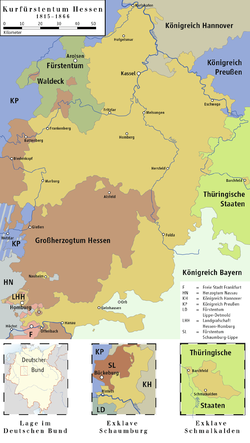Kurhessen
| Electorate of Hesse | ||||||||||||||
| Kurfürstentum Hessen | ||||||||||||||
|
State of the Holy Roman Empire State of the German Confederation |
||||||||||||||
|
||||||||||||||
|
||||||||||||||
|
Hesse-Kassel in 1866
|
||||||||||||||
| Capital | Kassel | |||||||||||||
| Languages | German | |||||||||||||
| Religion | Protestant (Calvinist) | |||||||||||||
| Government | Absolute monarchy | |||||||||||||
| Elector of Hesse | ||||||||||||||
| • | 1803–1821 | William I, Elector of Hesse | ||||||||||||
| • | 1821–1847 | William II, Elector of Hesse | ||||||||||||
| • | 1847–1866 | Frederick William, Elector of Hesse | ||||||||||||
| History | ||||||||||||||
| • | Established | 1803 | ||||||||||||
| • | Raised to Electorate | 1803 | ||||||||||||
| • | Annexed by France | 1807 | ||||||||||||
| • | Reestablished | 1814 | ||||||||||||
| • | Annexed by Kingdom of Prussia | 1866 | ||||||||||||
| Area | ||||||||||||||
| • | 1864 | 9,581 km² (3,699 sq mi) | ||||||||||||
| Population | ||||||||||||||
| • | 1864 est. | 745,063 | ||||||||||||
| Density | 77.8 /km² (201.4 /sq mi) | |||||||||||||
| Currency |
Hesse-Kassel thaler (to 1858) Hesse-Kassel vereinsthaler (1858–1873) |
|||||||||||||
|
||||||||||||||
| Today part of |
|
|||||||||||||
The Electorate of Hesse (also known as Hesse-Kassel) was a state elevated by Napoleon in 1803 from the Landgraviate of Hesse-Kassel. When the Holy Roman Empire was abolished in 1806, the Prince-Elector of Hesse chose to remain an Elector, even though there was no longer an Emperor to elect. In 1807, with the Treaties of Tilsit the area was annexed to the Kingdom of Westphalia, but in 1814 the Congress of Vienna restored the electorate.
The state—last of its kind—consisted of several detached territories to the north of Frankfurt which survived until 1866 with the name of an electorate within the German Confederation. It comprised a total land area of 3,699 square miles (9,580 km2), and its population in 1864 was 745,063.
The Landgraviate of Hesse-Kassel originated in 1567 with the division of the Landgraviate of Hesse between the heirs of Philip I of Hesse ("the Magnanimous") after his death. Philip's eldest son, William IV, received Hesse-Kassel, which comprised about half the area of the Landgraviate of Hesse, including the capital, Kassel. William's brothers received Hesse-Marburg und Hesse-Rheinfels, but their lines died out within a generation and the territories then reverted to Hesse-Kassel and to the Landgraviate of Hesse-Darmstadt.
The reign of the Landgrave William IX was an important epoch in the history of Hesse-Kassel. Ascending the throne in 1785, he took part in the War of the First Coalition against French First Republic a few years later, but in 1795 the Peace of Basel was signed. In 1801 he lost his possessions on the left bank of the Rhine, but in 1803 he was compensated for these losses with some former French territory round Mainz, and at the same time he was raised to the dignity of Prince-elector (Kurfürst) William I, a title he retained even after the dissolution of the Holy Roman Empire.
...
Wikipedia



